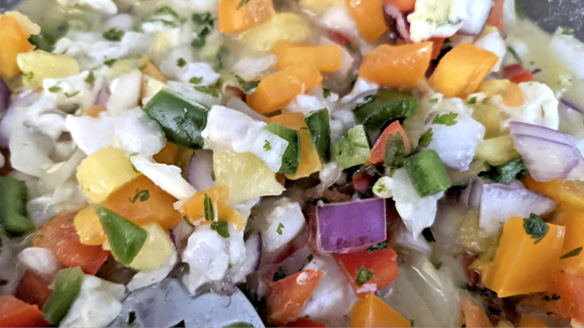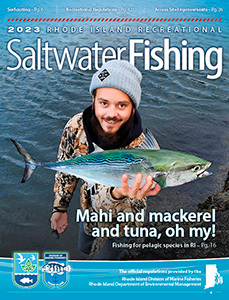Striped Searobin Diet

Ceviche is a Peruvian dish made from fresh raw fish that is marinated in some sort of acidic liquid, typically citrus juice. Because the fish is not cooked with heat, but rather cured from the acidity of the citrus, only the freshest fish should be used. Any mild fish with a firm texture works well, and during peak fishing season in RI, black sea bass is the perfect candidate. Light, refreshing, and colorful, black sea bass ceviche is the perfect summertime seafood dish.
Ingredients:
- 2 black sea bass filets (about 2 cups)
- 1 lime (juice and zest)
- 1 lemon (juice and zest)
- 1/4 cup of chopped or crushed pineapple (with juice)
- 1/2 of a red onion
- 1/2 of a white onion
- 1/2 cup of bell pepper (any color)
- 1-2 jalapenos (diced)
- 1 tablespoon finely chopped garlic
- Handful of finely chopped cilantro
- 1-2 teaspoons of salt (to taste)
- 1-2 teaspoons of sugar (to taste)
- Cut sea bass filets into ½-inch cubes. Place in large bowl.
- Using a microplane or grater, zest the lime and lemon and add. Avoid grating too deep – only add the green/yellow outer skin. The white pith below tastes bitter.
- Add the lime and lemon juice.
- Add the pineapple and juice.
- Dice the onions. Add both (about ¼ cup of each).
- Dice the bell pepper, about ½ cup. I like to mix colors, so typically use ½ of a pepper of each color. Green bell peppers taste vegetal, while orange, yellow, and red taste sweeter (due to being riper).
- Dice the jalapeno. Always taste first, as their heat level can vary greatly! Remove the seeds and white pith if you want less heat.
- Add the chopped garlic and cilantro.
- Add the salt and sugar.
- Mix well, making sure the fish is completely coated in liquid. Let sit refrigerated for 1-2 hours, until fish turns opaque white (and looks cooked). If needed, add more salt or sugar to taste.
- Serve with tortilla chips and enjoy! Best consumed the same day, but can be kept refrigerated up to 2 days. If storing, drain excess liquid.
By Katie Rodrigue, Principal Biologist, RI DMF

